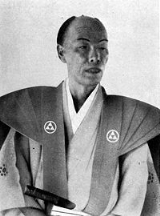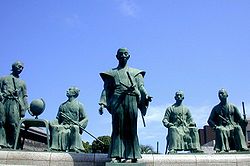
Yokoi Shounan
Encyclopedia

; was a Bakumatsu and early Meiji period
Meiji period
The , also known as the Meiji era, is a Japanese era which extended from September 1868 through July 1912. This period represents the first half of the Empire of Japan.- Meiji Restoration and the emperor :...
scholar and political reformer in Japan
Japan
Japan is an island nation in East Asia. Located in the Pacific Ocean, it lies to the east of the Sea of Japan, China, North Korea, South Korea and Russia, stretching from the Sea of Okhotsk in the north to the East China Sea and Taiwan in the south...
, influential around the fall of the Tokugawa bakufu. His real name was Yokoi Tokiari.
Life and career
Yokoi was a samurai born in KumamotoKumamoto, Kumamoto
is the capital city of Kumamoto Prefecture on the island of Kyushu, Japan. Greater Kumamoto has a population of 1,460,000, as of the 2000 census...
, Higo Province
Higo Province
Higo Province was an old province of Japan in the area that is today Kumamoto Prefecture on the island of Kyūshū. It was sometimes called , with Hizen Province. Higo bordered on Chikugo, Bungo, Hyūga, Ōsumi, and Satsuma Provinces....
(present-day Kumamoto Prefecture
Kumamoto Prefecture
is a prefecture of Japan located on Kyushu Island. The capital is the city of Kumamoto.- History :Historically the area was called Higo Province; and the province was renamed Kumamoto during the Meiji Restoration. The creation of prefectures was part of the abolition of the feudal system...
), and a distant descendant of Hōjō Takatoki
Hojo Takatoki
Hōjō Takatoki was the last Tokuso and ruling Shikken of Japan's Kamakura shogunate; the latter ones were his puppets, a member of the Hōjō clan, he was the son of Hōjō Sadatoki, and was preceded as shikken by Hōjō Morotoki.Takatoki became regent at the age of eight, and thus actual power was...
. He was sent by the domain to Edo
Edo
, also romanized as Yedo or Yeddo, is the former name of the Japanese capital Tokyo, and was the seat of power for the Tokugawa shogunate which ruled Japan from 1603 to 1868...
in 1839 for studies, and developed contacts with pro-reform members of the Mito domain
Mito, Ibaraki
is the capital of Ibaraki Prefecture, Japan and has a central location, moderately offset towards the coast in that prefecture. As of 2005, the city has an estimated population of 263,748 and a total area is 217.45 km², giving a population density of 1,212.91 persons per km²...
. After his return to Kumamoto, he started a group to promote the reform of domain administration along Neo-Confucianism
Neo-Confucianism
Neo-Confucianism is an ethical and metaphysical Chinese philosophy influenced by Confucianism, that was primarily developed during the Song Dynasty and Ming Dynasty, but which can be traced back to Han Yu and Li Ao in the Tang Dynasty....
lines, opening a domain school called Shōnan-do.
In 1857, he was invited by the daimyō
Daimyo
is a generic term referring to the powerful territorial lords in pre-modern Japan who ruled most of the country from their vast, hereditary land holdings...
of Echizen
Echizen Province
was an old province of Japan, which is today the northern part of Fukui Prefecture. It was sometimes called , with Etchū and Echigo Provinces.Echizen is famous for washi . A text dated AD 774 mentions the washi made in this area. Echizen-produced Washi is still the most commonly sold traditional...
, Matsudaira Yoshinaga
Matsudaira Yoshinaga
, also known as Matsudaira Keiei, was the 14th head of Fukui Domain during the Late Tokugawa shogunate and politician of the Meiji era. "Yoshinaga" is his imina and "Shungaku" is his gō...
to become his political advisor. While in Fukui
Fukui, Fukui
is the capital of Fukui Prefecture, Japan. The city is located in the north-central part of the prefecture on the coast of the Sea of Japan.-Demographics:...
, Yokoi wrote "Kokuze Sanron" (the Three Major Discussion of State Policy). One of the topics covered in Yokoi’s treatise was on state religion
State religion
A state religion is a religious body or creed officially endorsed by the state...
, in which Yokoi commented that although Japan had Buddhism
Buddhism
Buddhism is a religion and philosophy encompassing a variety of traditions, beliefs and practices, largely based on teachings attributed to Siddhartha Gautama, commonly known as the Buddha . The Buddha lived and taught in the northeastern Indian subcontinent some time between the 6th and 4th...
, Shinto
Shinto
or Shintoism, also kami-no-michi, is the indigenous spirituality of Japan and the Japanese people. It is a set of practices, to be carried out diligently, to establish a connection between present day Japan and its ancient past. Shinto practices were first recorded and codified in the written...
, and Confucianism
Confucianism
Confucianism is a Chinese ethical and philosophical system developed from the teachings of the Chinese philosopher Confucius . Confucianism originated as an "ethical-sociopolitical teaching" during the Spring and Autumn Period, but later developed metaphysical and cosmological elements in the Han...
, it lacked a true national religion in the manner of western nations, and that this lack was a weakness in the Japanese kokutai
Kokutai
Kokutai is a politically loaded word in the Japanese language, translatable as "sovereign", "national identity; national essence; national character" or "national polity; body politic; national entity; basis for the Emperor's sovereignty; Japanese constitution". "Sovereign" is perhaps the most...
, which placed Japan at a disadvantage to the western powers. This concept provided one rationale underpinning the formation of State Shinto
State Shinto
has been called the state religion of the Empire of Japan, although it did not exist as a single institution and no "Shintō" was ever declared a state religion...
in the later Meiji period
Meiji period
The , also known as the Meiji era, is a Japanese era which extended from September 1868 through July 1912. This period represents the first half of the Empire of Japan.- Meiji Restoration and the emperor :...
Empire of Japan
Empire of Japan
The Empire of Japan is the name of the state of Japan that existed from the Meiji Restoration on 3 January 1868 to the enactment of the post-World War II Constitution of...
. In the same treatise, he also stressed the importance of a strong navy for the defense of Japan.
In 1862, Matsudaira was unexpectedly made acting prime minister of the Tokugawa administration (seiji sōsai) in a move calculated to obtain imperial approval for the Shogun's actions in signing unequal treaties
Unequal Treaties
“Unequal treaty” is a term used in specific reference to a number of treaties imposed by Western powers, during the 19th and early 20th centuries, on Qing Dynasty China and late Tokugawa Japan...
with the western powers in 1858, ending the national seclusion
Sakoku
was the foreign relations policy of Japan under which no foreigner could enter nor could any Japanese leave the country on penalty of death. The policy was enacted by the Tokugawa shogunate under Tokugawa Iemitsu through a number of edicts and policies from 1633–39 and remained in effect until...
policy which was supported by the Imperial Court, and Yokoi accompanied him to Edo.
Yokoi called for a complete reform of the Tokugawa government, including reconciliation between the Shogunate and the Imperial Court. He also called for the complete opening of Japan to foreign trade, economic reform, and establishment of a modern military along western lines. He also called for a national assembly
National Assembly
National Assembly is either a legislature, or the lower house of a bicameral legislature in some countries. The best known National Assembly, and the first legislature to be known by this title, was that established during the French Revolution in 1789, known as the Assemblée nationale...
of the major domains, with the Shogun evolving into something that resembled a prime minister
Prime minister
A prime minister is the most senior minister of cabinet in the executive branch of government in a parliamentary system. In many systems, the prime minister selects and may dismiss other members of the cabinet, and allocates posts to members within the government. In most systems, the prime...
. Outraged and astounded by these radical ideas, conservatives within the government quickly stripped Yokoi of his posts, and even his samurai status, and placed him under house arrest
House arrest
In justice and law, house arrest is a measure by which a person is confined by the authorities to his or her residence. Travel is usually restricted, if allowed at all...
in Kumamoto. However, while in exile, Yokoi continued to maintain contact with Katsu Kaishū
Katsu Kaishu
was a Japanese statesman, naval engineer during the Late Tokugawa shogunate and early Meiji period. Kaishū was a nickname which he took from a piece of calligraphy by Sakuma Shōzan. He went through a series of given names throughout his life; his childhood name was and his real name was...
and other reform-minded members of government.
After the Meiji Restoration
Meiji Restoration
The , also known as the Meiji Ishin, Revolution, Reform or Renewal, was a chain of events that restored imperial rule to Japan in 1868...
, Yokoi was freed by the new Meiji government, and honored with the title of san'yo (councilor). However, Yokoi was assassinated in 1869 by conservative samurai who suspected him of being a Christian
Christian
A Christian is a person who adheres to Christianity, an Abrahamic, monotheistic religion based on the life and teachings of Jesus of Nazareth as recorded in the Canonical gospels and the letters of the New Testament...
, and of harboring secret republican
Republicanism
Republicanism is the ideology of governing a nation as a republic, where the head of state is appointed by means other than heredity, often elections. The exact meaning of republicanism varies depending on the cultural and historical context...
sentiments.

